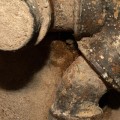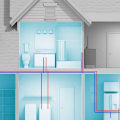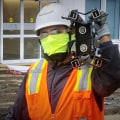When it comes to plumbing leaks, it can be difficult to determine the source. To help you get to the bottom of the problem quickly, here are 10 tips from experienced plumbers. The first step is to look for signs of overwatering, such as greener grass or moisture in the joints or on the bottom of the P trap when you open the cabinet doors and shine a flashlight inside. Corrosion on supply line fittings and valves can also indicate a leaky pipe.
Clean the cabinet and examine the bottom for stains of water, moisture, mold or mildew and bent or peeled material. If you turn off all the water in the house and the leak stops soon after, it's likely coming from inside your home. However, if it continues to flow, it's probably coming from outside. Stains on the ceiling or walls, bubbling or peeling paint or wallpaper, and mold, mildew, or rotting wood around these pipes can all point to a pipe leak.
If you suspect a leak in your plumbing system, contact a professional plumber to inspect and repair it. They can confirm its location before you start tearing off walls or floors. David is chairman of the Committee of the Council of Master Plumbers and has served on the Executive Committee of the New York Subsurface Plumbers Association for more than 30 years. According to Shepherd's Plumbing Heating AC, if your water meter needle has moved, this indicates that there is a leak somewhere in your plumbing system.




Leave a Comment